Comprehensive Report on Change Management Theories & Impact
VerifiedAdded on 2023/06/15
|12
|2814
|161
Report
AI Summary
This report provides a comprehensive analysis of various change management theories, including Lewin's change management model, the McKinsey 7-S model, Kotter's theory, Nudge theory, the ADKAR model, Bridges' transition model, Kübler-Ross' change curve, and the Satir change management model. It explores how these theories affect organizations, emphasizing the importance of employee support and clear communication during change implementation. The report concludes by highlighting the need for managers to proactively identify and manage changes, ensuring that employees are adequately supported throughout the process, and emphasizes the role of employee participation and feedback in successful change management initiatives. Desklib provides access to this solved assignment and other study resources for students.
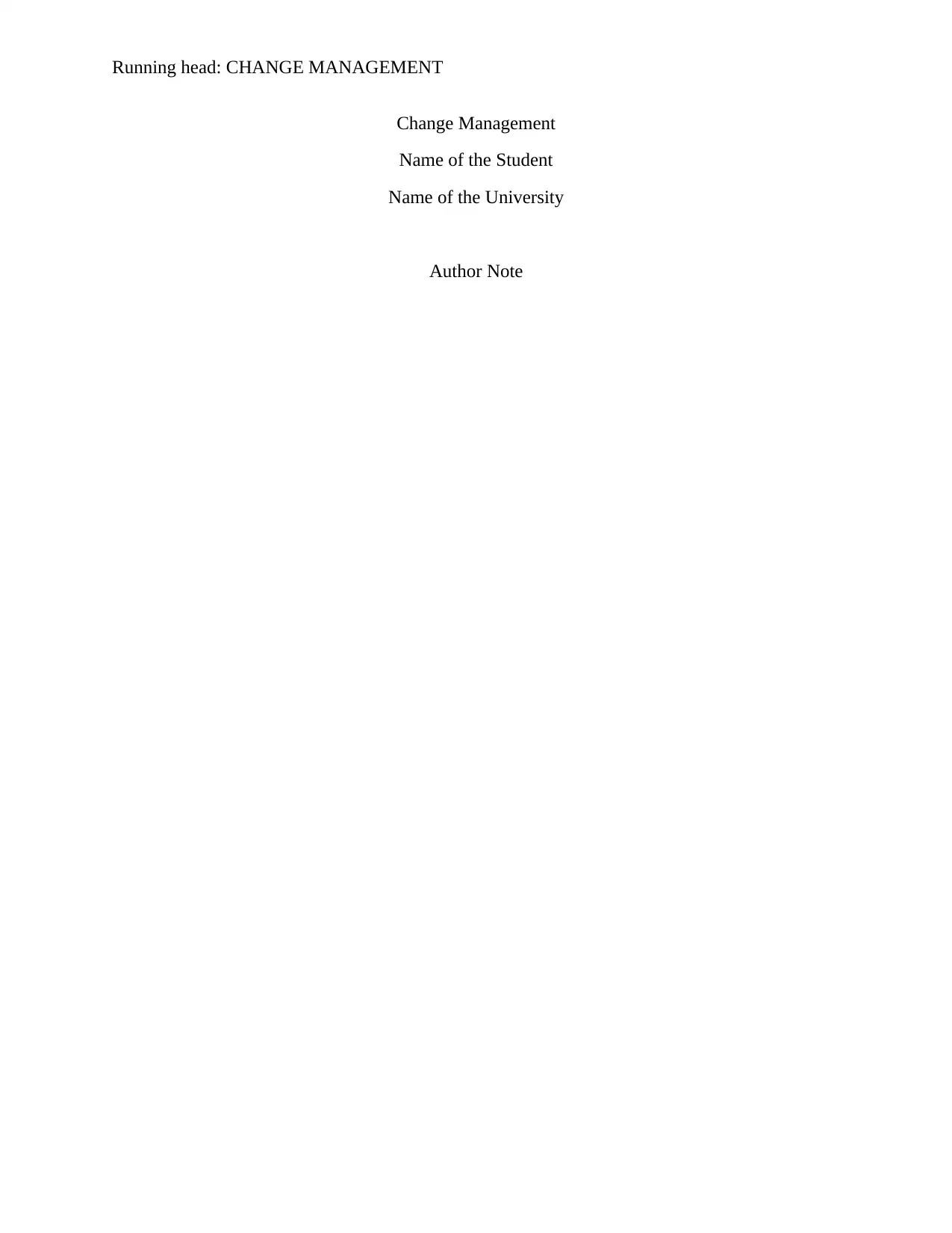
Running head: CHANGE MANAGEMENT
Change Management
Name of the Student
Name of the University
Author Note
Change Management
Name of the Student
Name of the University
Author Note
Secure Best Marks with AI Grader
Need help grading? Try our AI Grader for instant feedback on your assignments.
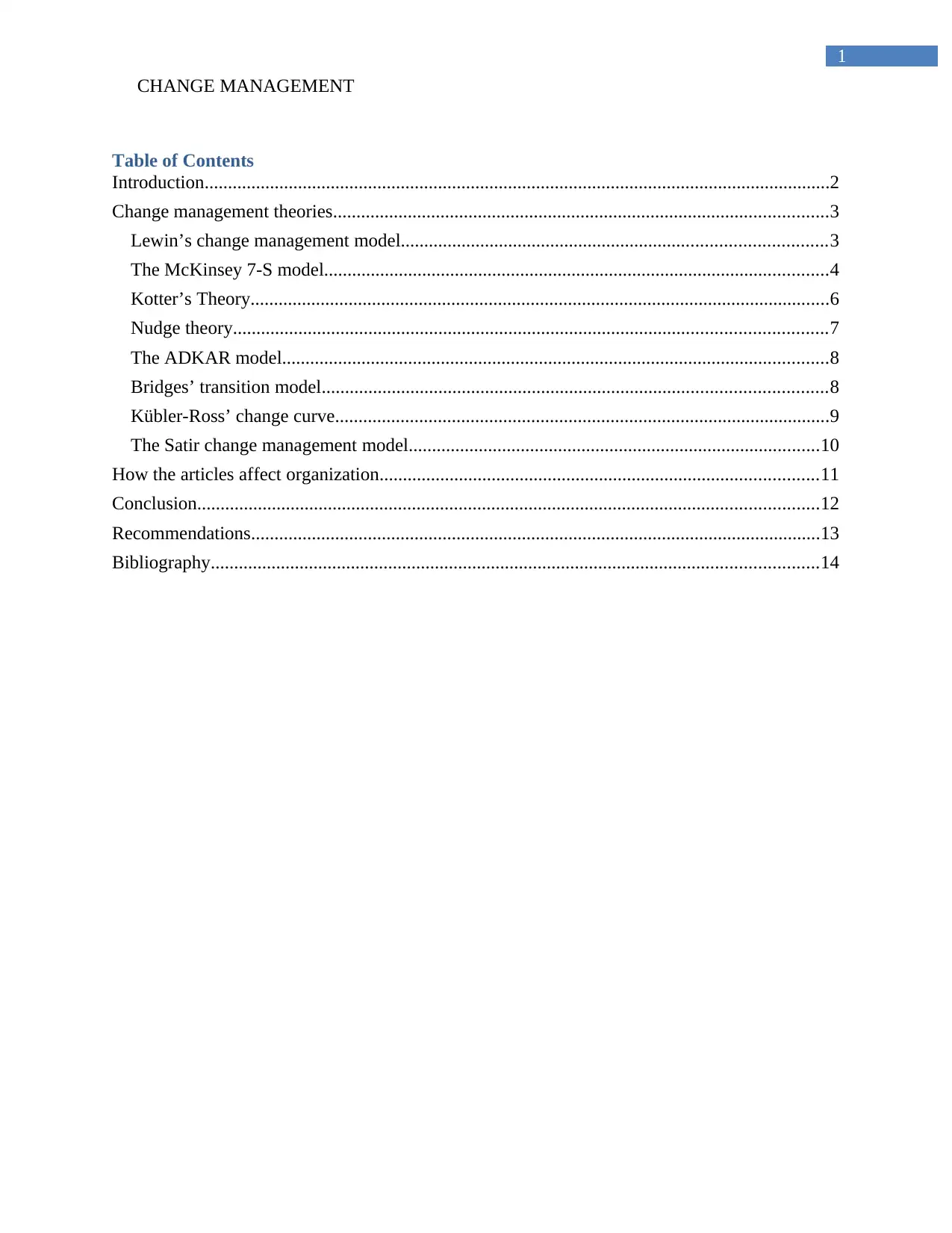
1
CHANGE MANAGEMENT
Table of Contents
Introduction......................................................................................................................................2
Change management theories..........................................................................................................3
Lewin’s change management model...........................................................................................3
The McKinsey 7-S model............................................................................................................4
Kotter’s Theory............................................................................................................................6
Nudge theory...............................................................................................................................7
The ADKAR model.....................................................................................................................8
Bridges’ transition model............................................................................................................8
Kübler-Ross’ change curve..........................................................................................................9
The Satir change management model........................................................................................10
How the articles affect organization..............................................................................................11
Conclusion.....................................................................................................................................12
Recommendations..........................................................................................................................13
Bibliography..................................................................................................................................14
CHANGE MANAGEMENT
Table of Contents
Introduction......................................................................................................................................2
Change management theories..........................................................................................................3
Lewin’s change management model...........................................................................................3
The McKinsey 7-S model............................................................................................................4
Kotter’s Theory............................................................................................................................6
Nudge theory...............................................................................................................................7
The ADKAR model.....................................................................................................................8
Bridges’ transition model............................................................................................................8
Kübler-Ross’ change curve..........................................................................................................9
The Satir change management model........................................................................................10
How the articles affect organization..............................................................................................11
Conclusion.....................................................................................................................................12
Recommendations..........................................................................................................................13
Bibliography..................................................................................................................................14
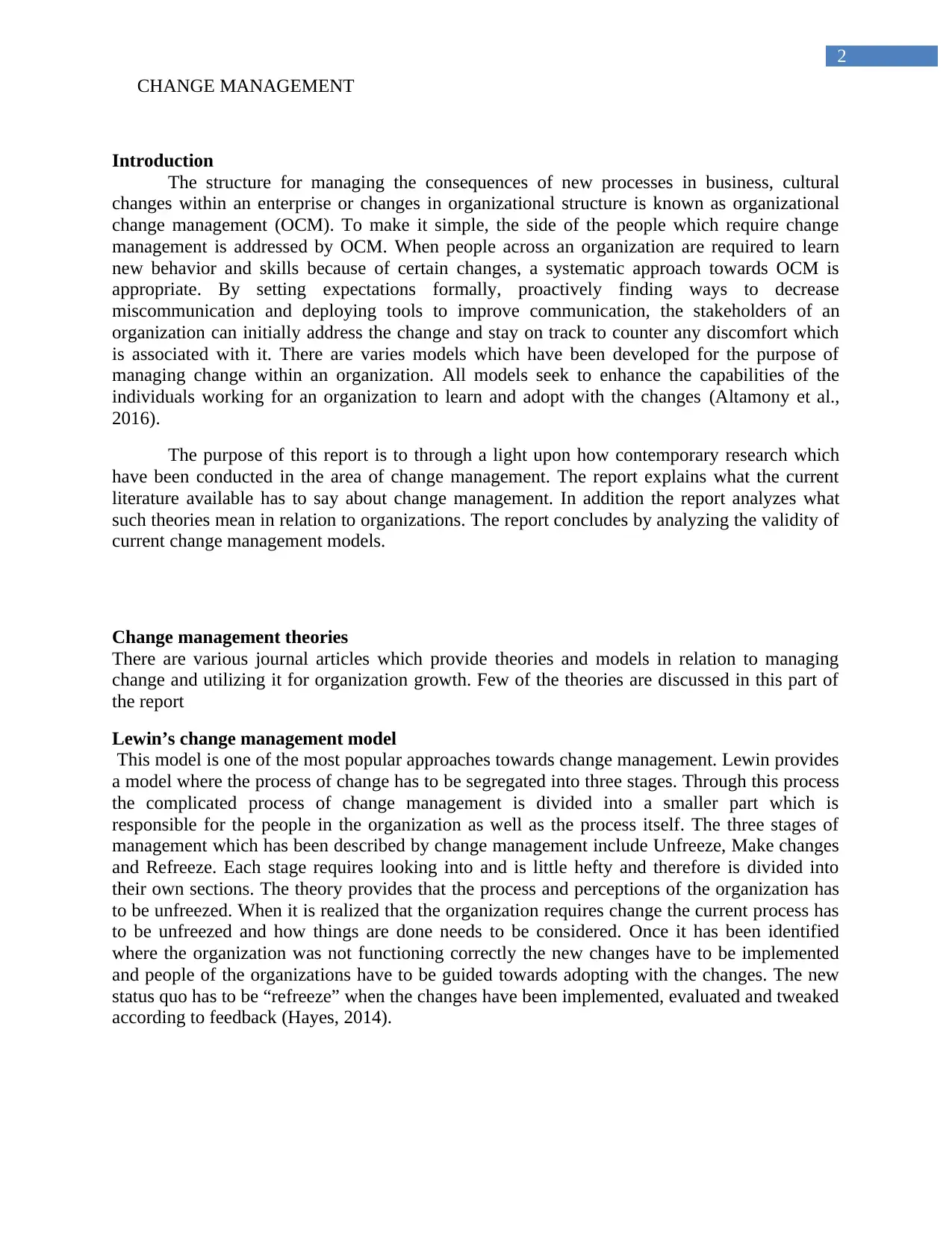
2
CHANGE MANAGEMENT
Introduction
The structure for managing the consequences of new processes in business, cultural
changes within an enterprise or changes in organizational structure is known as organizational
change management (OCM). To make it simple, the side of the people which require change
management is addressed by OCM. When people across an organization are required to learn
new behavior and skills because of certain changes, a systematic approach towards OCM is
appropriate. By setting expectations formally, proactively finding ways to decrease
miscommunication and deploying tools to improve communication, the stakeholders of an
organization can initially address the change and stay on track to counter any discomfort which
is associated with it. There are varies models which have been developed for the purpose of
managing change within an organization. All models seek to enhance the capabilities of the
individuals working for an organization to learn and adopt with the changes (Altamony et al.,
2016).
The purpose of this report is to through a light upon how contemporary research which
have been conducted in the area of change management. The report explains what the current
literature available has to say about change management. In addition the report analyzes what
such theories mean in relation to organizations. The report concludes by analyzing the validity of
current change management models.
Change management theories
There are various journal articles which provide theories and models in relation to managing
change and utilizing it for organization growth. Few of the theories are discussed in this part of
the report
Lewin’s change management model
This model is one of the most popular approaches towards change management. Lewin provides
a model where the process of change has to be segregated into three stages. Through this process
the complicated process of change management is divided into a smaller part which is
responsible for the people in the organization as well as the process itself. The three stages of
management which has been described by change management include Unfreeze, Make changes
and Refreeze. Each stage requires looking into and is little hefty and therefore is divided into
their own sections. The theory provides that the process and perceptions of the organization has
to be unfreezed. When it is realized that the organization requires change the current process has
to be unfreezed and how things are done needs to be considered. Once it has been identified
where the organization was not functioning correctly the new changes have to be implemented
and people of the organizations have to be guided towards adopting with the changes. The new
status quo has to be “refreeze” when the changes have been implemented, evaluated and tweaked
according to feedback (Hayes, 2014).
CHANGE MANAGEMENT
Introduction
The structure for managing the consequences of new processes in business, cultural
changes within an enterprise or changes in organizational structure is known as organizational
change management (OCM). To make it simple, the side of the people which require change
management is addressed by OCM. When people across an organization are required to learn
new behavior and skills because of certain changes, a systematic approach towards OCM is
appropriate. By setting expectations formally, proactively finding ways to decrease
miscommunication and deploying tools to improve communication, the stakeholders of an
organization can initially address the change and stay on track to counter any discomfort which
is associated with it. There are varies models which have been developed for the purpose of
managing change within an organization. All models seek to enhance the capabilities of the
individuals working for an organization to learn and adopt with the changes (Altamony et al.,
2016).
The purpose of this report is to through a light upon how contemporary research which
have been conducted in the area of change management. The report explains what the current
literature available has to say about change management. In addition the report analyzes what
such theories mean in relation to organizations. The report concludes by analyzing the validity of
current change management models.
Change management theories
There are various journal articles which provide theories and models in relation to managing
change and utilizing it for organization growth. Few of the theories are discussed in this part of
the report
Lewin’s change management model
This model is one of the most popular approaches towards change management. Lewin provides
a model where the process of change has to be segregated into three stages. Through this process
the complicated process of change management is divided into a smaller part which is
responsible for the people in the organization as well as the process itself. The three stages of
management which has been described by change management include Unfreeze, Make changes
and Refreeze. Each stage requires looking into and is little hefty and therefore is divided into
their own sections. The theory provides that the process and perceptions of the organization has
to be unfreezed. When it is realized that the organization requires change the current process has
to be unfreezed and how things are done needs to be considered. Once it has been identified
where the organization was not functioning correctly the new changes have to be implemented
and people of the organizations have to be guided towards adopting with the changes. The new
status quo has to be “refreeze” when the changes have been implemented, evaluated and tweaked
according to feedback (Hayes, 2014).
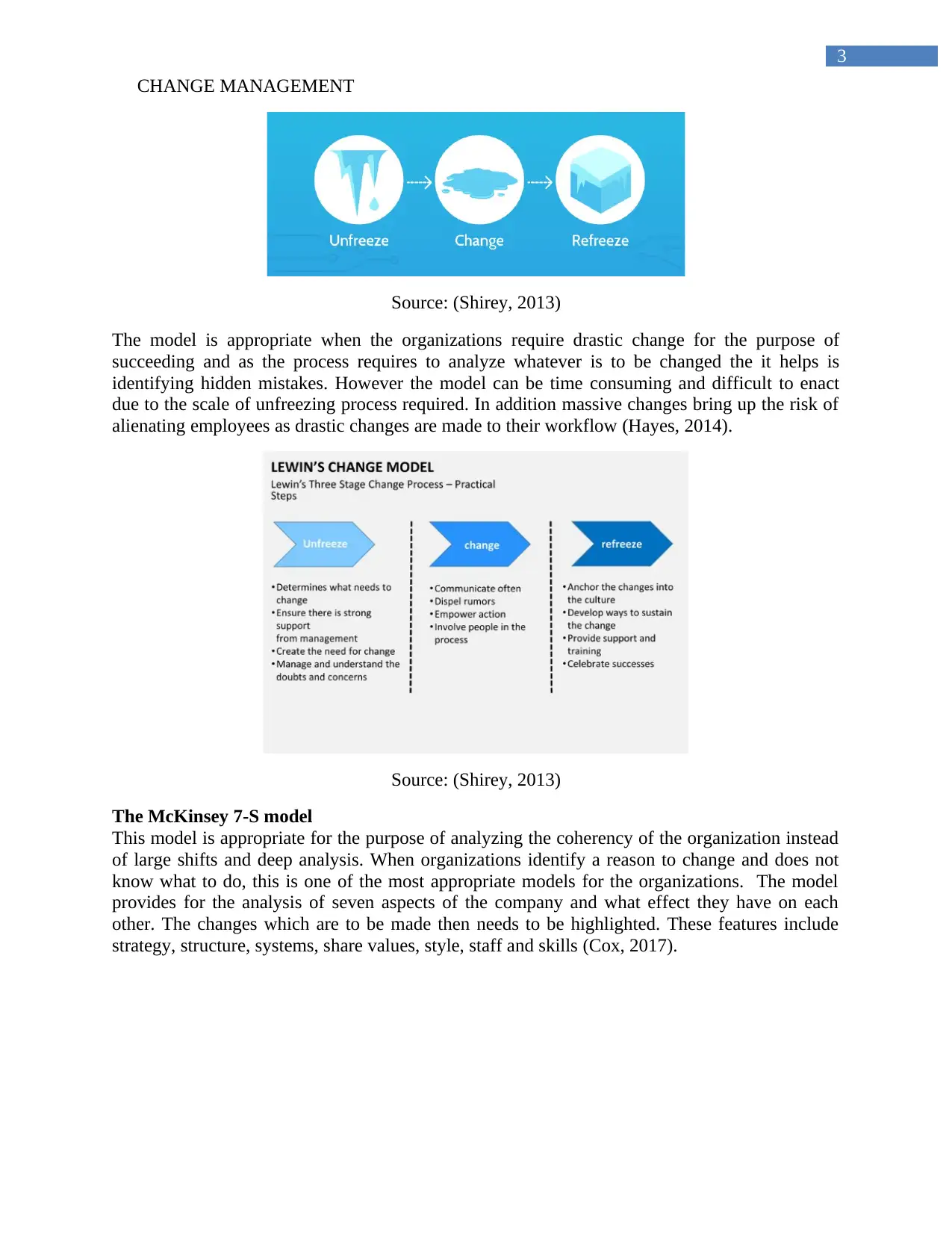
3
CHANGE MANAGEMENT
Source: (Shirey, 2013)
The model is appropriate when the organizations require drastic change for the purpose of
succeeding and as the process requires to analyze whatever is to be changed the it helps is
identifying hidden mistakes. However the model can be time consuming and difficult to enact
due to the scale of unfreezing process required. In addition massive changes bring up the risk of
alienating employees as drastic changes are made to their workflow (Hayes, 2014).
Source: (Shirey, 2013)
The McKinsey 7-S model
This model is appropriate for the purpose of analyzing the coherency of the organization instead
of large shifts and deep analysis. When organizations identify a reason to change and does not
know what to do, this is one of the most appropriate models for the organizations. The model
provides for the analysis of seven aspects of the company and what effect they have on each
other. The changes which are to be made then needs to be highlighted. These features include
strategy, structure, systems, share values, style, staff and skills (Cox, 2017).
CHANGE MANAGEMENT
Source: (Shirey, 2013)
The model is appropriate when the organizations require drastic change for the purpose of
succeeding and as the process requires to analyze whatever is to be changed the it helps is
identifying hidden mistakes. However the model can be time consuming and difficult to enact
due to the scale of unfreezing process required. In addition massive changes bring up the risk of
alienating employees as drastic changes are made to their workflow (Hayes, 2014).
Source: (Shirey, 2013)
The McKinsey 7-S model
This model is appropriate for the purpose of analyzing the coherency of the organization instead
of large shifts and deep analysis. When organizations identify a reason to change and does not
know what to do, this is one of the most appropriate models for the organizations. The model
provides for the analysis of seven aspects of the company and what effect they have on each
other. The changes which are to be made then needs to be highlighted. These features include
strategy, structure, systems, share values, style, staff and skills (Cox, 2017).
Secure Best Marks with AI Grader
Need help grading? Try our AI Grader for instant feedback on your assignments.
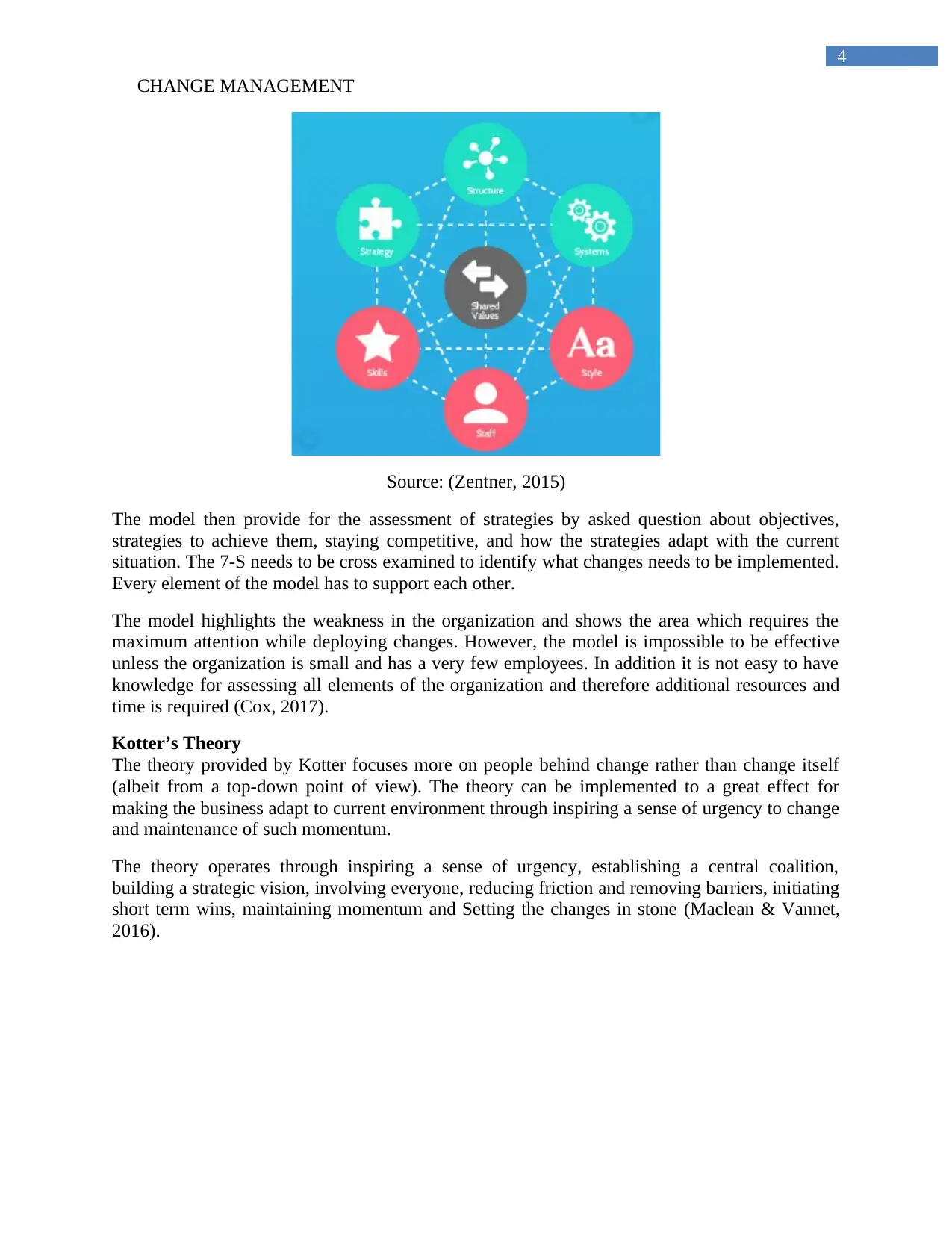
4
CHANGE MANAGEMENT
Source: (Zentner, 2015)
The model then provide for the assessment of strategies by asked question about objectives,
strategies to achieve them, staying competitive, and how the strategies adapt with the current
situation. The 7-S needs to be cross examined to identify what changes needs to be implemented.
Every element of the model has to support each other.
The model highlights the weakness in the organization and shows the area which requires the
maximum attention while deploying changes. However, the model is impossible to be effective
unless the organization is small and has a very few employees. In addition it is not easy to have
knowledge for assessing all elements of the organization and therefore additional resources and
time is required (Cox, 2017).
Kotter’s Theory
The theory provided by Kotter focuses more on people behind change rather than change itself
(albeit from a top-down point of view). The theory can be implemented to a great effect for
making the business adapt to current environment through inspiring a sense of urgency to change
and maintenance of such momentum.
The theory operates through inspiring a sense of urgency, establishing a central coalition,
building a strategic vision, involving everyone, reducing friction and removing barriers, initiating
short term wins, maintaining momentum and Setting the changes in stone (Maclean & Vannet,
2016).
CHANGE MANAGEMENT
Source: (Zentner, 2015)
The model then provide for the assessment of strategies by asked question about objectives,
strategies to achieve them, staying competitive, and how the strategies adapt with the current
situation. The 7-S needs to be cross examined to identify what changes needs to be implemented.
Every element of the model has to support each other.
The model highlights the weakness in the organization and shows the area which requires the
maximum attention while deploying changes. However, the model is impossible to be effective
unless the organization is small and has a very few employees. In addition it is not easy to have
knowledge for assessing all elements of the organization and therefore additional resources and
time is required (Cox, 2017).
Kotter’s Theory
The theory provided by Kotter focuses more on people behind change rather than change itself
(albeit from a top-down point of view). The theory can be implemented to a great effect for
making the business adapt to current environment through inspiring a sense of urgency to change
and maintenance of such momentum.
The theory operates through inspiring a sense of urgency, establishing a central coalition,
building a strategic vision, involving everyone, reducing friction and removing barriers, initiating
short term wins, maintaining momentum and Setting the changes in stone (Maclean & Vannet,
2016).
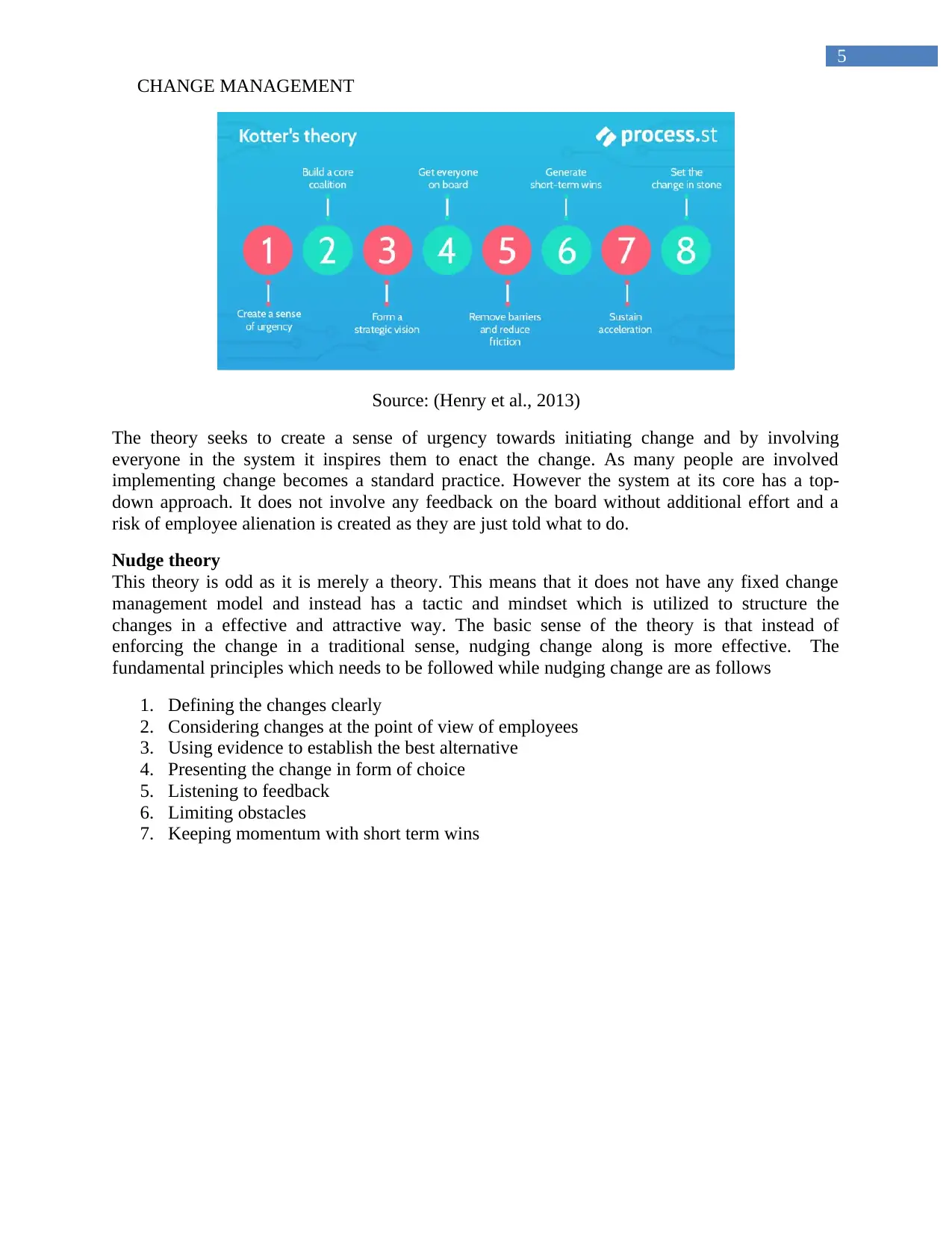
5
CHANGE MANAGEMENT
Source: (Henry et al., 2013)
The theory seeks to create a sense of urgency towards initiating change and by involving
everyone in the system it inspires them to enact the change. As many people are involved
implementing change becomes a standard practice. However the system at its core has a top-
down approach. It does not involve any feedback on the board without additional effort and a
risk of employee alienation is created as they are just told what to do.
Nudge theory
This theory is odd as it is merely a theory. This means that it does not have any fixed change
management model and instead has a tactic and mindset which is utilized to structure the
changes in a effective and attractive way. The basic sense of the theory is that instead of
enforcing the change in a traditional sense, nudging change along is more effective. The
fundamental principles which needs to be followed while nudging change are as follows
1. Defining the changes clearly
2. Considering changes at the point of view of employees
3. Using evidence to establish the best alternative
4. Presenting the change in form of choice
5. Listening to feedback
6. Limiting obstacles
7. Keeping momentum with short term wins
CHANGE MANAGEMENT
Source: (Henry et al., 2013)
The theory seeks to create a sense of urgency towards initiating change and by involving
everyone in the system it inspires them to enact the change. As many people are involved
implementing change becomes a standard practice. However the system at its core has a top-
down approach. It does not involve any feedback on the board without additional effort and a
risk of employee alienation is created as they are just told what to do.
Nudge theory
This theory is odd as it is merely a theory. This means that it does not have any fixed change
management model and instead has a tactic and mindset which is utilized to structure the
changes in a effective and attractive way. The basic sense of the theory is that instead of
enforcing the change in a traditional sense, nudging change along is more effective. The
fundamental principles which needs to be followed while nudging change are as follows
1. Defining the changes clearly
2. Considering changes at the point of view of employees
3. Using evidence to establish the best alternative
4. Presenting the change in form of choice
5. Listening to feedback
6. Limiting obstacles
7. Keeping momentum with short term wins
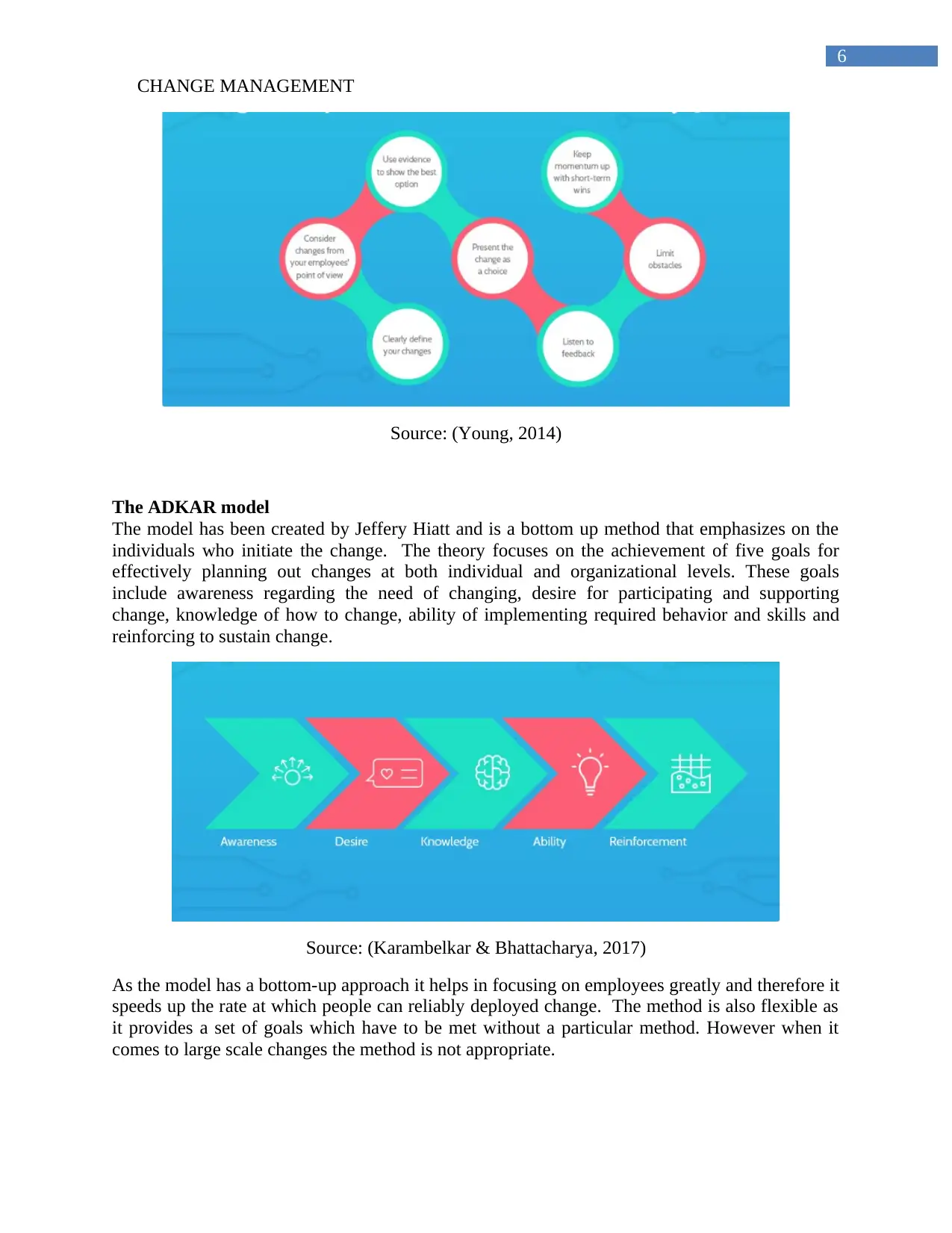
6
CHANGE MANAGEMENT
Source: (Young, 2014)
The ADKAR model
The model has been created by Jeffery Hiatt and is a bottom up method that emphasizes on the
individuals who initiate the change. The theory focuses on the achievement of five goals for
effectively planning out changes at both individual and organizational levels. These goals
include awareness regarding the need of changing, desire for participating and supporting
change, knowledge of how to change, ability of implementing required behavior and skills and
reinforcing to sustain change.
Source: (Karambelkar & Bhattacharya, 2017)
As the model has a bottom-up approach it helps in focusing on employees greatly and therefore it
speeds up the rate at which people can reliably deployed change. The method is also flexible as
it provides a set of goals which have to be met without a particular method. However when it
comes to large scale changes the method is not appropriate.
CHANGE MANAGEMENT
Source: (Young, 2014)
The ADKAR model
The model has been created by Jeffery Hiatt and is a bottom up method that emphasizes on the
individuals who initiate the change. The theory focuses on the achievement of five goals for
effectively planning out changes at both individual and organizational levels. These goals
include awareness regarding the need of changing, desire for participating and supporting
change, knowledge of how to change, ability of implementing required behavior and skills and
reinforcing to sustain change.
Source: (Karambelkar & Bhattacharya, 2017)
As the model has a bottom-up approach it helps in focusing on employees greatly and therefore it
speeds up the rate at which people can reliably deployed change. The method is also flexible as
it provides a set of goals which have to be met without a particular method. However when it
comes to large scale changes the method is not appropriate.
Paraphrase This Document
Need a fresh take? Get an instant paraphrase of this document with our AI Paraphraser
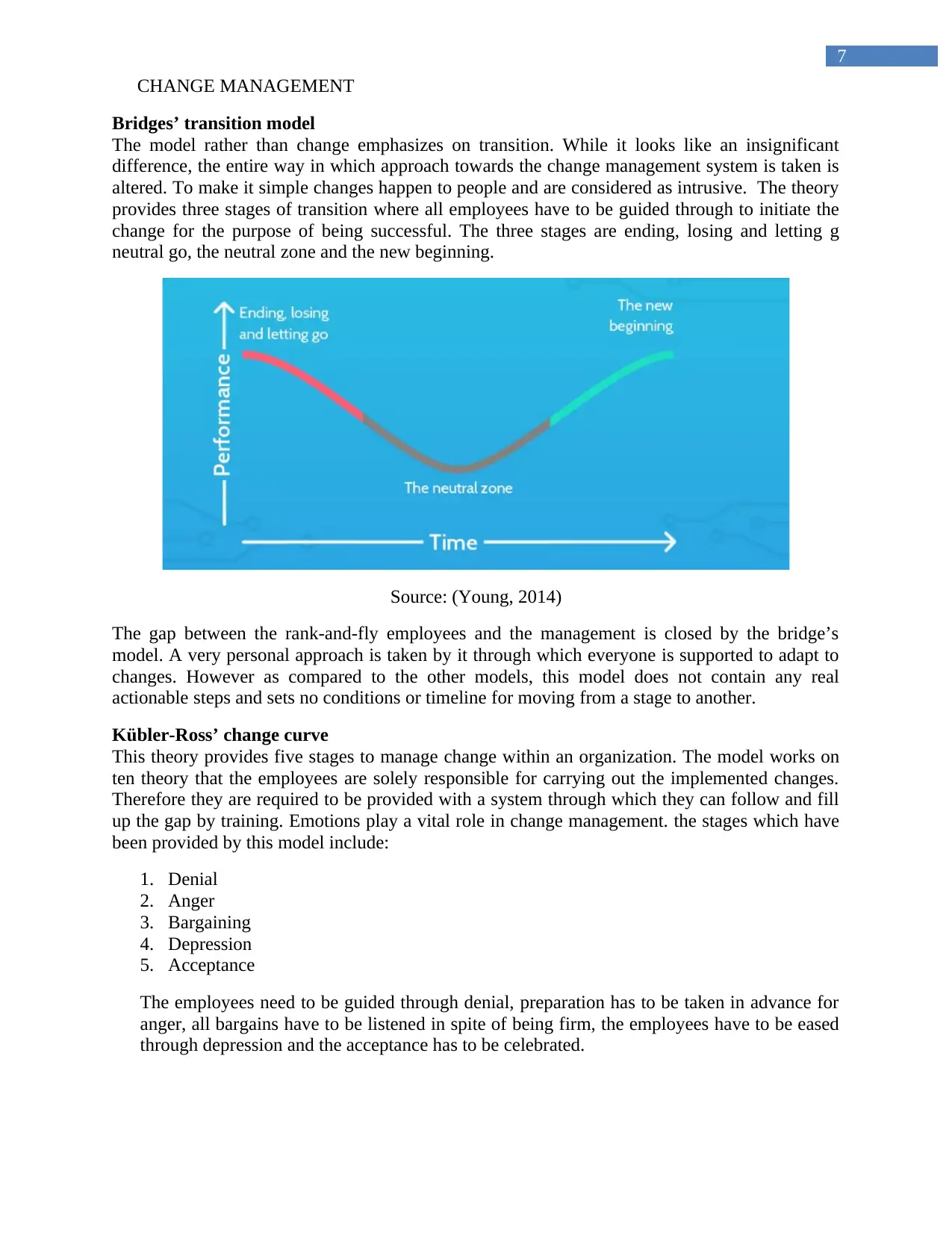
7
CHANGE MANAGEMENT
Bridges’ transition model
The model rather than change emphasizes on transition. While it looks like an insignificant
difference, the entire way in which approach towards the change management system is taken is
altered. To make it simple changes happen to people and are considered as intrusive. The theory
provides three stages of transition where all employees have to be guided through to initiate the
change for the purpose of being successful. The three stages are ending, losing and letting g
neutral go, the neutral zone and the new beginning.
Source: (Young, 2014)
The gap between the rank-and-fly employees and the management is closed by the bridge’s
model. A very personal approach is taken by it through which everyone is supported to adapt to
changes. However as compared to the other models, this model does not contain any real
actionable steps and sets no conditions or timeline for moving from a stage to another.
Kübler-Ross’ change curve
This theory provides five stages to manage change within an organization. The model works on
ten theory that the employees are solely responsible for carrying out the implemented changes.
Therefore they are required to be provided with a system through which they can follow and fill
up the gap by training. Emotions play a vital role in change management. the stages which have
been provided by this model include:
1. Denial
2. Anger
3. Bargaining
4. Depression
5. Acceptance
The employees need to be guided through denial, preparation has to be taken in advance for
anger, all bargains have to be listened in spite of being firm, the employees have to be eased
through depression and the acceptance has to be celebrated.
CHANGE MANAGEMENT
Bridges’ transition model
The model rather than change emphasizes on transition. While it looks like an insignificant
difference, the entire way in which approach towards the change management system is taken is
altered. To make it simple changes happen to people and are considered as intrusive. The theory
provides three stages of transition where all employees have to be guided through to initiate the
change for the purpose of being successful. The three stages are ending, losing and letting g
neutral go, the neutral zone and the new beginning.
Source: (Young, 2014)
The gap between the rank-and-fly employees and the management is closed by the bridge’s
model. A very personal approach is taken by it through which everyone is supported to adapt to
changes. However as compared to the other models, this model does not contain any real
actionable steps and sets no conditions or timeline for moving from a stage to another.
Kübler-Ross’ change curve
This theory provides five stages to manage change within an organization. The model works on
ten theory that the employees are solely responsible for carrying out the implemented changes.
Therefore they are required to be provided with a system through which they can follow and fill
up the gap by training. Emotions play a vital role in change management. the stages which have
been provided by this model include:
1. Denial
2. Anger
3. Bargaining
4. Depression
5. Acceptance
The employees need to be guided through denial, preparation has to be taken in advance for
anger, all bargains have to be listened in spite of being firm, the employees have to be eased
through depression and the acceptance has to be celebrated.
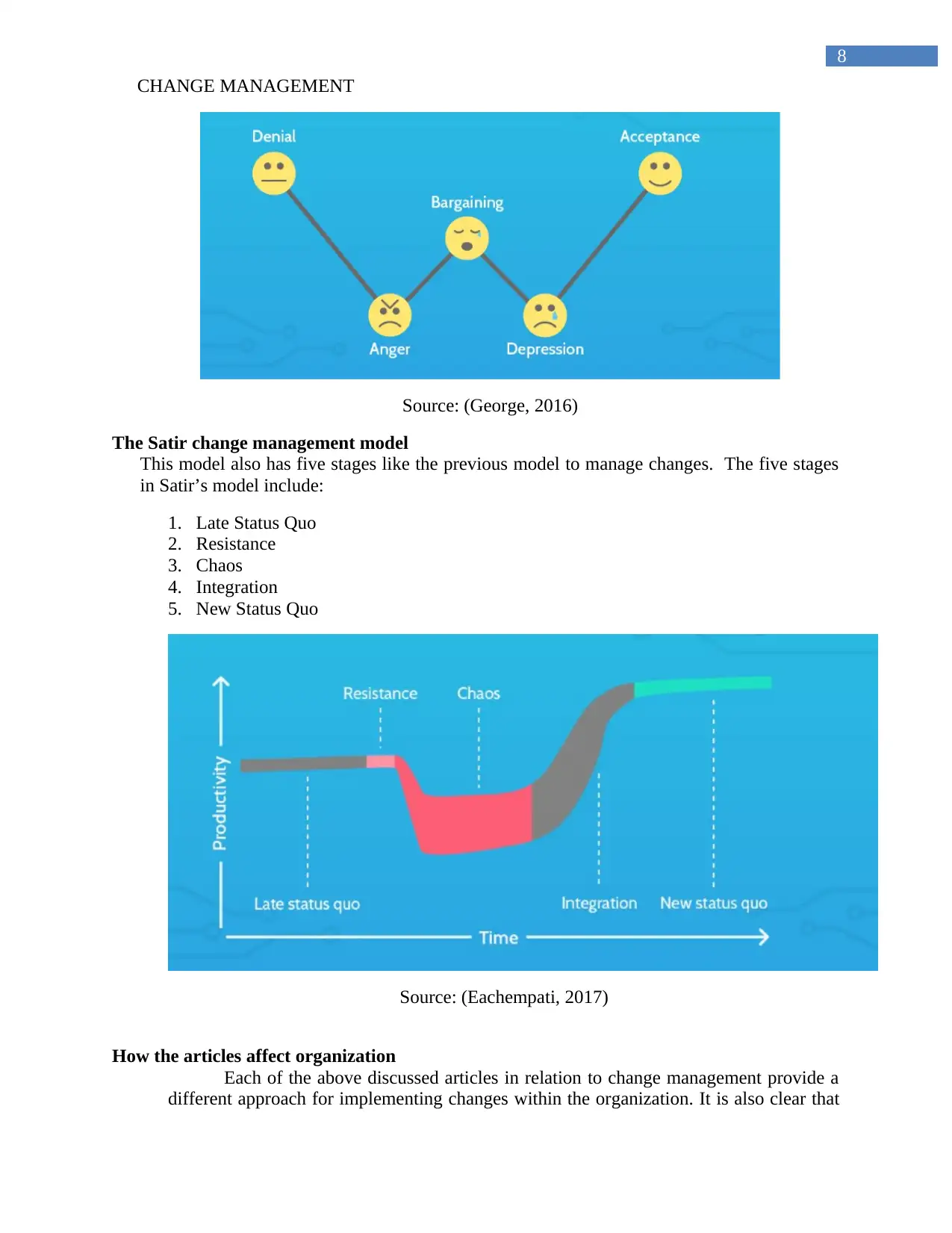
8
CHANGE MANAGEMENT
Source: (George, 2016)
The Satir change management model
This model also has five stages like the previous model to manage changes. The five stages
in Satir’s model include:
1. Late Status Quo
2. Resistance
3. Chaos
4. Integration
5. New Status Quo
Source: (Eachempati, 2017)
How the articles affect organization
Each of the above discussed articles in relation to change management provide a
different approach for implementing changes within the organization. It is also clear that
CHANGE MANAGEMENT
Source: (George, 2016)
The Satir change management model
This model also has five stages like the previous model to manage changes. The five stages
in Satir’s model include:
1. Late Status Quo
2. Resistance
3. Chaos
4. Integration
5. New Status Quo
Source: (Eachempati, 2017)
How the articles affect organization
Each of the above discussed articles in relation to change management provide a
different approach for implementing changes within the organization. It is also clear that
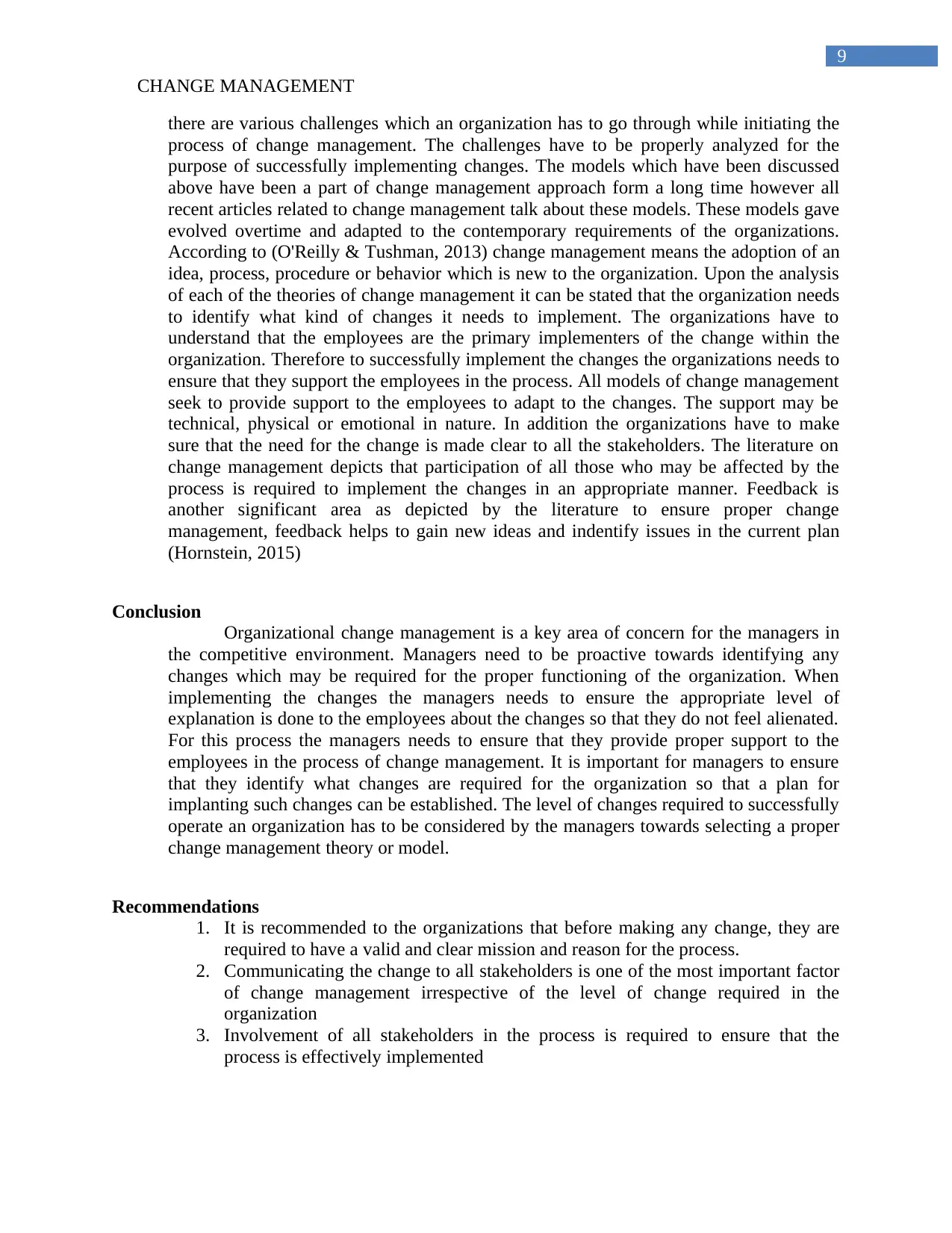
9
CHANGE MANAGEMENT
there are various challenges which an organization has to go through while initiating the
process of change management. The challenges have to be properly analyzed for the
purpose of successfully implementing changes. The models which have been discussed
above have been a part of change management approach form a long time however all
recent articles related to change management talk about these models. These models gave
evolved overtime and adapted to the contemporary requirements of the organizations.
According to (O'Reilly & Tushman, 2013) change management means the adoption of an
idea, process, procedure or behavior which is new to the organization. Upon the analysis
of each of the theories of change management it can be stated that the organization needs
to identify what kind of changes it needs to implement. The organizations have to
understand that the employees are the primary implementers of the change within the
organization. Therefore to successfully implement the changes the organizations needs to
ensure that they support the employees in the process. All models of change management
seek to provide support to the employees to adapt to the changes. The support may be
technical, physical or emotional in nature. In addition the organizations have to make
sure that the need for the change is made clear to all the stakeholders. The literature on
change management depicts that participation of all those who may be affected by the
process is required to implement the changes in an appropriate manner. Feedback is
another significant area as depicted by the literature to ensure proper change
management, feedback helps to gain new ideas and indentify issues in the current plan
(Hornstein, 2015)
Conclusion
Organizational change management is a key area of concern for the managers in
the competitive environment. Managers need to be proactive towards identifying any
changes which may be required for the proper functioning of the organization. When
implementing the changes the managers needs to ensure the appropriate level of
explanation is done to the employees about the changes so that they do not feel alienated.
For this process the managers needs to ensure that they provide proper support to the
employees in the process of change management. It is important for managers to ensure
that they identify what changes are required for the organization so that a plan for
implanting such changes can be established. The level of changes required to successfully
operate an organization has to be considered by the managers towards selecting a proper
change management theory or model.
Recommendations
1. It is recommended to the organizations that before making any change, they are
required to have a valid and clear mission and reason for the process.
2. Communicating the change to all stakeholders is one of the most important factor
of change management irrespective of the level of change required in the
organization
3. Involvement of all stakeholders in the process is required to ensure that the
process is effectively implemented
CHANGE MANAGEMENT
there are various challenges which an organization has to go through while initiating the
process of change management. The challenges have to be properly analyzed for the
purpose of successfully implementing changes. The models which have been discussed
above have been a part of change management approach form a long time however all
recent articles related to change management talk about these models. These models gave
evolved overtime and adapted to the contemporary requirements of the organizations.
According to (O'Reilly & Tushman, 2013) change management means the adoption of an
idea, process, procedure or behavior which is new to the organization. Upon the analysis
of each of the theories of change management it can be stated that the organization needs
to identify what kind of changes it needs to implement. The organizations have to
understand that the employees are the primary implementers of the change within the
organization. Therefore to successfully implement the changes the organizations needs to
ensure that they support the employees in the process. All models of change management
seek to provide support to the employees to adapt to the changes. The support may be
technical, physical or emotional in nature. In addition the organizations have to make
sure that the need for the change is made clear to all the stakeholders. The literature on
change management depicts that participation of all those who may be affected by the
process is required to implement the changes in an appropriate manner. Feedback is
another significant area as depicted by the literature to ensure proper change
management, feedback helps to gain new ideas and indentify issues in the current plan
(Hornstein, 2015)
Conclusion
Organizational change management is a key area of concern for the managers in
the competitive environment. Managers need to be proactive towards identifying any
changes which may be required for the proper functioning of the organization. When
implementing the changes the managers needs to ensure the appropriate level of
explanation is done to the employees about the changes so that they do not feel alienated.
For this process the managers needs to ensure that they provide proper support to the
employees in the process of change management. It is important for managers to ensure
that they identify what changes are required for the organization so that a plan for
implanting such changes can be established. The level of changes required to successfully
operate an organization has to be considered by the managers towards selecting a proper
change management theory or model.
Recommendations
1. It is recommended to the organizations that before making any change, they are
required to have a valid and clear mission and reason for the process.
2. Communicating the change to all stakeholders is one of the most important factor
of change management irrespective of the level of change required in the
organization
3. Involvement of all stakeholders in the process is required to ensure that the
process is effectively implemented
Secure Best Marks with AI Grader
Need help grading? Try our AI Grader for instant feedback on your assignments.
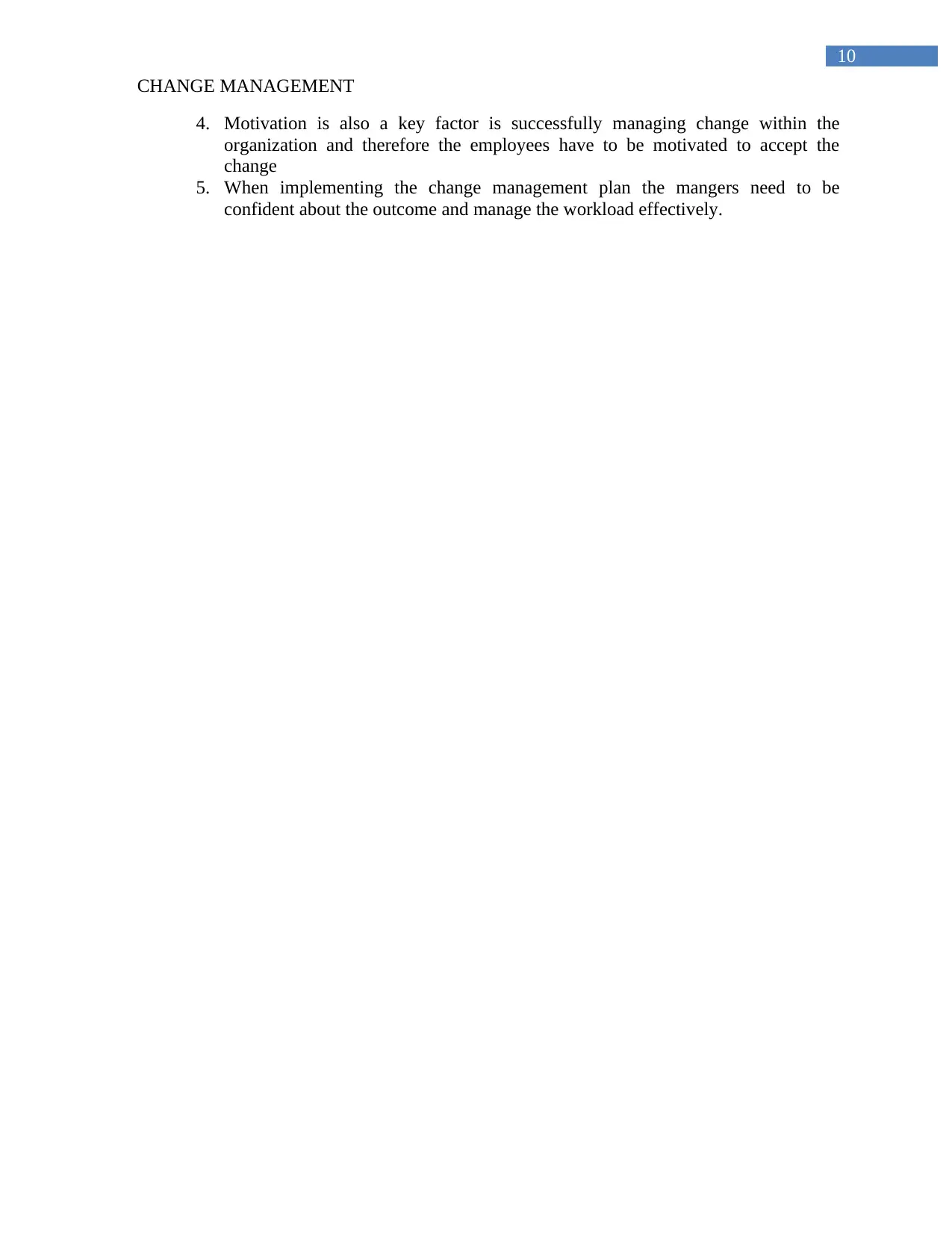
10
CHANGE MANAGEMENT
4. Motivation is also a key factor is successfully managing change within the
organization and therefore the employees have to be motivated to accept the
change
5. When implementing the change management plan the mangers need to be
confident about the outcome and manage the workload effectively.
CHANGE MANAGEMENT
4. Motivation is also a key factor is successfully managing change within the
organization and therefore the employees have to be motivated to accept the
change
5. When implementing the change management plan the mangers need to be
confident about the outcome and manage the workload effectively.
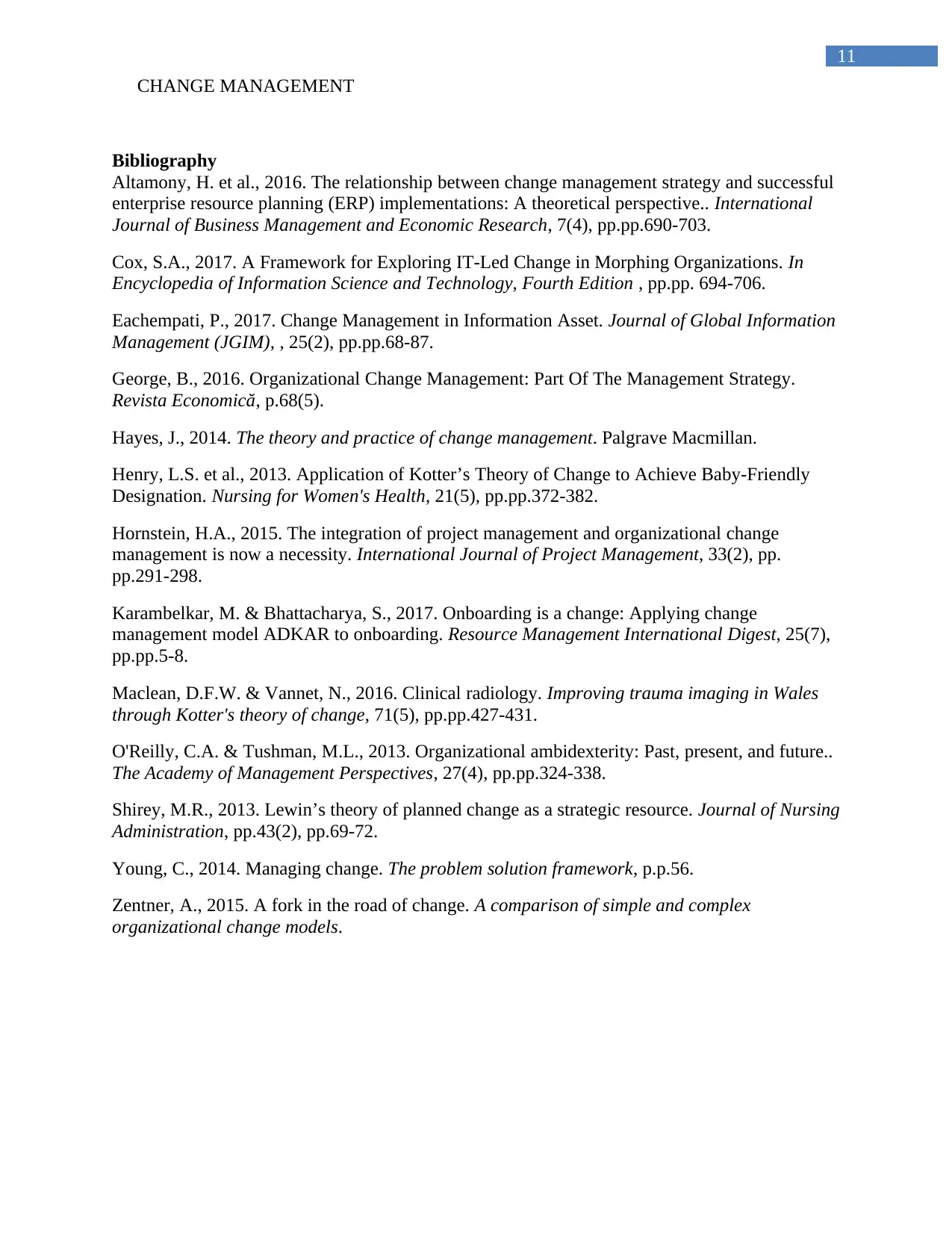
11
CHANGE MANAGEMENT
Bibliography
Altamony, H. et al., 2016. The relationship between change management strategy and successful
enterprise resource planning (ERP) implementations: A theoretical perspective.. International
Journal of Business Management and Economic Research, 7(4), pp.pp.690-703.
Cox, S.A., 2017. A Framework for Exploring IT-Led Change in Morphing Organizations. In
Encyclopedia of Information Science and Technology, Fourth Edition , pp.pp. 694-706.
Eachempati, P., 2017. Change Management in Information Asset. Journal of Global Information
Management (JGIM), , 25(2), pp.pp.68-87.
George, B., 2016. Organizational Change Management: Part Of The Management Strategy.
Revista Economică, p.68(5).
Hayes, J., 2014. The theory and practice of change management. Palgrave Macmillan.
Henry, L.S. et al., 2013. Application of Kotter’s Theory of Change to Achieve Baby-Friendly
Designation. Nursing for Women's Health, 21(5), pp.pp.372-382.
Hornstein, H.A., 2015. The integration of project management and organizational change
management is now a necessity. International Journal of Project Management, 33(2), pp.
pp.291-298.
Karambelkar, M. & Bhattacharya, S., 2017. Onboarding is a change: Applying change
management model ADKAR to onboarding. Resource Management International Digest, 25(7),
pp.pp.5-8.
Maclean, D.F.W. & Vannet, N., 2016. Clinical radiology. Improving trauma imaging in Wales
through Kotter's theory of change, 71(5), pp.pp.427-431.
O'Reilly, C.A. & Tushman, M.L., 2013. Organizational ambidexterity: Past, present, and future..
The Academy of Management Perspectives, 27(4), pp.pp.324-338.
Shirey, M.R., 2013. Lewin’s theory of planned change as a strategic resource. Journal of Nursing
Administration, pp.43(2), pp.69-72.
Young, C., 2014. Managing change. The problem solution framework, p.p.56.
Zentner, A., 2015. A fork in the road of change. A comparison of simple and complex
organizational change models.
CHANGE MANAGEMENT
Bibliography
Altamony, H. et al., 2016. The relationship between change management strategy and successful
enterprise resource planning (ERP) implementations: A theoretical perspective.. International
Journal of Business Management and Economic Research, 7(4), pp.pp.690-703.
Cox, S.A., 2017. A Framework for Exploring IT-Led Change in Morphing Organizations. In
Encyclopedia of Information Science and Technology, Fourth Edition , pp.pp. 694-706.
Eachempati, P., 2017. Change Management in Information Asset. Journal of Global Information
Management (JGIM), , 25(2), pp.pp.68-87.
George, B., 2016. Organizational Change Management: Part Of The Management Strategy.
Revista Economică, p.68(5).
Hayes, J., 2014. The theory and practice of change management. Palgrave Macmillan.
Henry, L.S. et al., 2013. Application of Kotter’s Theory of Change to Achieve Baby-Friendly
Designation. Nursing for Women's Health, 21(5), pp.pp.372-382.
Hornstein, H.A., 2015. The integration of project management and organizational change
management is now a necessity. International Journal of Project Management, 33(2), pp.
pp.291-298.
Karambelkar, M. & Bhattacharya, S., 2017. Onboarding is a change: Applying change
management model ADKAR to onboarding. Resource Management International Digest, 25(7),
pp.pp.5-8.
Maclean, D.F.W. & Vannet, N., 2016. Clinical radiology. Improving trauma imaging in Wales
through Kotter's theory of change, 71(5), pp.pp.427-431.
O'Reilly, C.A. & Tushman, M.L., 2013. Organizational ambidexterity: Past, present, and future..
The Academy of Management Perspectives, 27(4), pp.pp.324-338.
Shirey, M.R., 2013. Lewin’s theory of planned change as a strategic resource. Journal of Nursing
Administration, pp.43(2), pp.69-72.
Young, C., 2014. Managing change. The problem solution framework, p.p.56.
Zentner, A., 2015. A fork in the road of change. A comparison of simple and complex
organizational change models.
1 out of 12
Related Documents
Your All-in-One AI-Powered Toolkit for Academic Success.
+13062052269
info@desklib.com
Available 24*7 on WhatsApp / Email
![[object Object]](/_next/static/media/star-bottom.7253800d.svg)
Unlock your academic potential
© 2024 | Zucol Services PVT LTD | All rights reserved.




